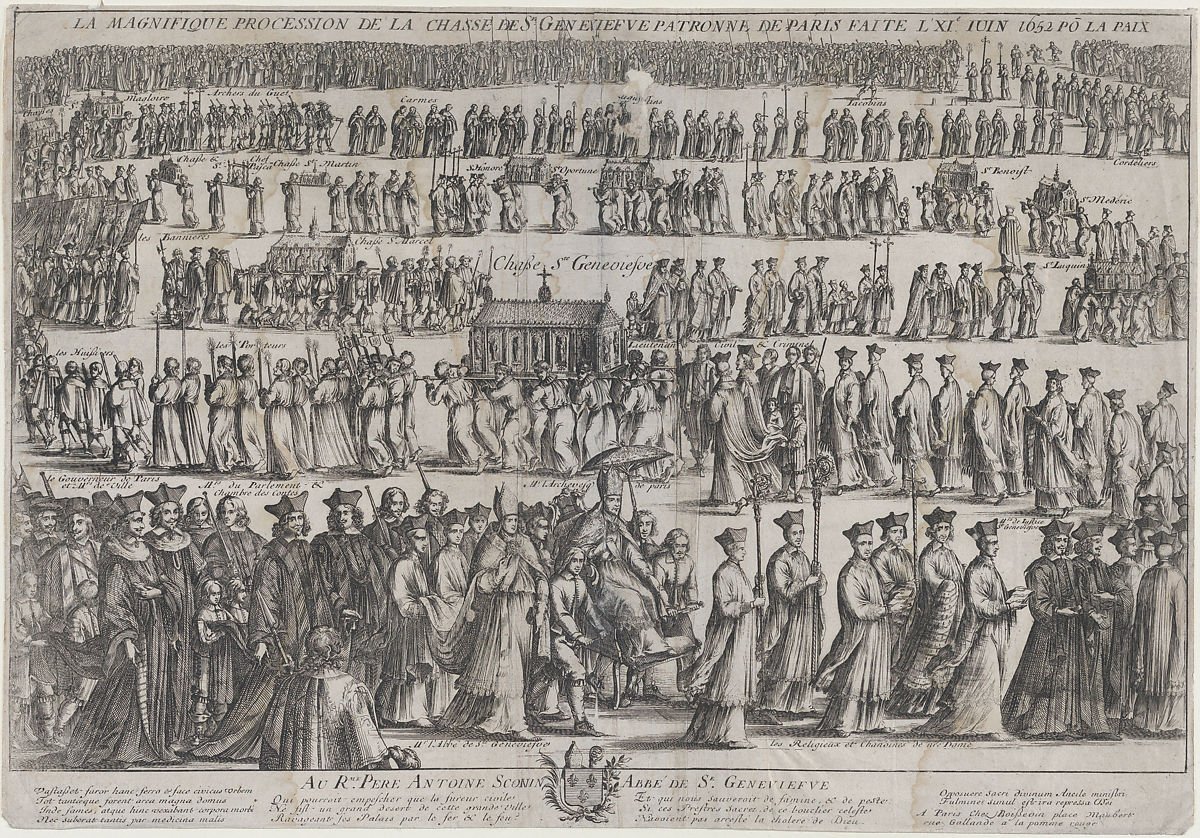Today, January 3 on the 1,510th anniversary of the death of Sainte Genevieve we begin a special two part episode of the life of the Patron Saint of Paris.
She stands on the banks of the Seine guarding the edge of Paris. Geneviève, the patron saint of Paris, was born around the year 420 in Nanterre, west of Paris. At the age of 7 she was blessed by St Germain, bishop of Auxerre, and from then on she dedicated her life to God Following the death of her parents a young Geneviève moved to Paris to live with her godmother, Lutetia.
As a child she was visited in visions by angels and saints and her family and village thought she was crazy. Saint Germain l’Auxerrois was always a supporter spreading the word that she was a child of God to be listened to. Her first miracle dates back to when she was just 8 years old. One sunday morning her mother told her she needed to stay home and not attend church where she was the talk of the village. Upset she spoke up to her mother which resulted in a slap to her face. Within minutes her mother went blind.
Two years later in 430, her mother asked Genevieve to retrieve water from the well. She spilled a bit and made the sign of the cross on her mothers face. Her mother wiped the water away and within a few minutes her sight returned.
Marcellus, Bishop of Paris appointed her to care and look after the welfare of virgins, but it would be her future deed that gives her place as the patron saint of Paris . In 451, Atilla the Hun and his army were on their way to Paris to take the city.
The young Geneviève gathered the frightened Parisians together to pray. Atilla's Huns changed their plans and headed to Orleans, saving Paris. In 464 she would do it again, this time during Childeric’s siege of Paris. She took a boat to Brie and Troyes numerous times, buying grain and returning to Paris and through his blockade to feed the starving people.
Genevive died on January 3, 512 and was buried alongside King Clovis and his wife Queen Clotilde in the Abbey of Sainte Genevieve built by Clovis. In 630, Saint Eloi had her shrine covered in gold and precious stones. Over time it was moved and somewhat destroyed. In 1240 Bonnard, a Parisian goldsmith repaired it and 400 years later in 1614 Marie de Medici had it rebuilt again. In 1793 during the French Revolution, she was moved to the Monnaie (mint) where her shrine was melted down and the precious stones removed.
Between 1500 and 1793 the reliquary of Sainte Genevieve was called on more than 120 times to save Paris from weather events, plaques and attacks. In May 1694 France had suffered a very dry winter that turned into spring. Famine spread through the countryside and the government had exhausted every resource they had. They went to Louis XIV and asked if he would allow a ceremony to be held calling on Sainte Genevieve to bring them a miracle.
On May 27, 1694 the abbey was filled with the sick and invalid and a grand ceremony was planned. Involving another saint, church and government officials and thousands of Parisians were part of the procession that started at Notre Dame de Paris. There were specific instructions that needed to be followed. The relics of Saint Marcel, held in Notre Dame had to first leave the Ile de la Cité. With church officials the procession traveled up the Montagne Sainte Geneviève to the door of the abbey. Once inside the reliquary of Saint Marcel was placed next to that of Sainte Genevieve on the altar. After a full mass the two then departed with hundreds in tow and thousands lining the streets back to Notre Dame. After another mass Marcel walked Genevieve to the end of the Petit Pont where he bid her adieu and then she returned home.
As she was taken back into the church the sky turned dark and the clouds opened and after many long months rain had returned. In 1725 she was brought out again, this time to stop the rain. These episodes were captured in Jollain Francois’s engraving that will later be turned into stained glass.
On 21 November 1793 her bones were burnt on the Place de Greve in front of the Hotel de Ville. The Revolutionists paraded her remains slowly through the city wanting everyone to see their beloved saint burned so she could no longer save them. Her ashes were thrown into the Seine, the same Seine she used to save the people of Paris many times.
The shrine seen today in the Eglise Saint Etienne de Mont holds relics of her that had been sent to other churches in France prior to the Revolution. In the large shrine, the stones from the original sarcophagus that her body had laid on for thirteen hundred years.
Listen to todays newest episode of La Vie Creative - Paris History Avec a Hemingway podcast today and tune in next week for part two.





